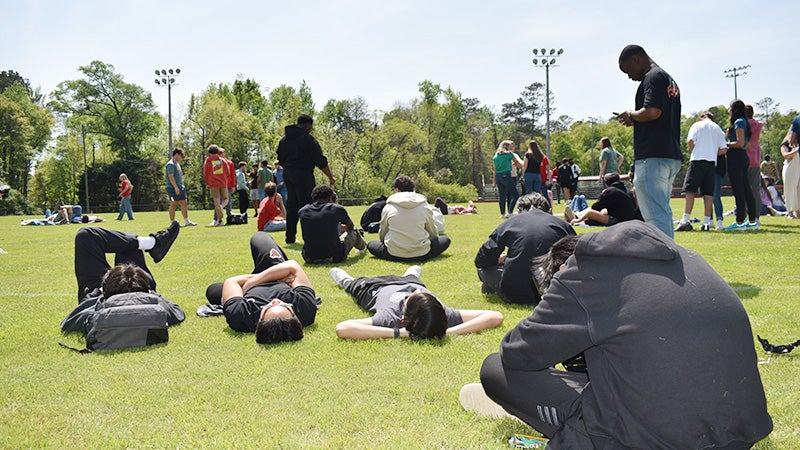Blinded by the Light: Springwood School hosts eclipse watch party
Published 6:35 pm Monday, April 8, 2024

- Springwood School students gather on the field to enjoy the view of the 2024 partial eclipse. --Charlotte Reames
|
Getting your Trinity Audio player ready...
|
“It looks like the Cheshire cat,” said Springwood seventh grader Gemma Clevenger, looking up at the partial eclipse on Monday with her classmates.
The entire Springwood School student body gathered on the field at 2:30 p.m. ET for an eclipse watch party. Kids chattered excitedly while enjoying Moon Pies and Capri-Suns.
The last total eclipse in the United States was in 2017. The totality of this year’s eclipse spanned from Salem, Oregon, to Charleston, South Carolina. In Alabama and Georgia, only a partial eclipse was visible, and on top of that, the weather wasn’t clear.
Springwood School decided to organize a special event for viewing the eclipse.
“I remember the last solar eclipse,” said Merrielle Key, a seventh-grade life science teacher. “We had one in 2017, but it was actually a very cloudy overcast day, and you could not see it this clear. I’ve never seen it quite like this …. I was really proud of our administration for having something like this.”
Songs like “Total Eclipse of the Heart” by Bonnie Tyler, “Moonshadow” by Cat Stevens and “Blinded by the Light” by Manfred Mann’s Earth Band played over the speakers on an eclipse playlist.
Clevenger and her classmate Madisyn Gibbons weren’t the only ones excited about the eclipse.
International student Kris Huynh purchased a special lens for his camera for the eclipse. He said many of his friends back home were jealous that he got to see the eclipse for himself.
“I’m like an astronomical nerd, so I really like it,” he said.
The eclipse began at around 1:45 p.m. ET and reached its peak at 3 p.m.
Key led a lesson with her students to help them understand what a solar eclipse is. The students recreated the eclipse in the classroom by moving the moon in front of the sun and blocking the light’s path to earth using a virtual program.
On Monday, the students got to see the real thing. Each had their own protective eyewear.
“I think [the sun] was about 25 percent [blocked] whenever we came out here, and now it’s almost reached totality,” Key said.




